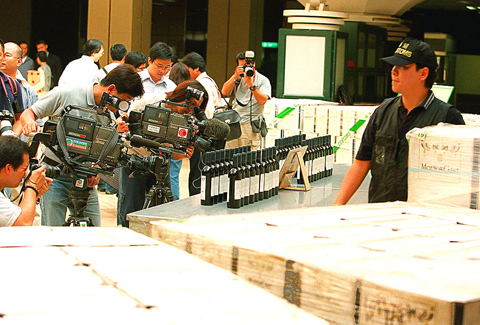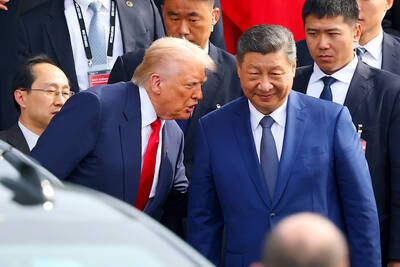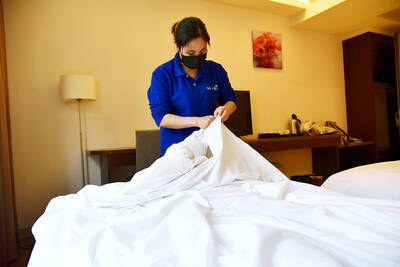Petrus, Romanee-Conti, Chateau d’Yquem — wines coveted by connoisseurs, and targeted by counterfeiters.
French wine professionals say a handful of rare and fine wines face the same threat from fraud as luxury handbags and designer sunglasses.
Trafficking in fake wine has “always existed a little, but it’s definitely amplified with the rising prices of fine wines,” said Sylvain Boivert, director of the association representing Bordeaux wines classified back in 1855, the Conseil des Grands Crus Classes en 1855.

PHOTO: AFP WARNING: EXCESSIVE CONSUMPTION OF ALCOHOL CAN DAMAGE
To the relief of many, the fakery remains on a small scale.
“We are not dealing with industrial counterfeit production, unlike the luxury brands,” he said.
The counterfeiting “touches five to six of the very top wine estates in Bordeaux where there is a real potential to make a capital gain and where there is a worldwide demand because the products are rare,” said wine tycoon Bernard Magrez, owner of 35 estates, including several in Bordeaux.
Nor have Bordeaux’s rarefied cousins in Burgundy been spared, notably Romanee-Conti, one of the world’s most expensive wines.
Jeroboams, the equivalent of four bottles, of the 1945 vintage from this 1.8 hectare estate have recently been sold in auctions, said Laurent Ponsot, a renowned Burgundy producer.
Alas, Romanee-Conti did not bottle their 1945 in jeroboams.
Ponsot, owner of Domaine Ponsot, has had his own misadventures with counterfeiters.
At a sale in New York last year, the vintner was shocked to discover that “106 bottles out of 107” were fakes. The catalogue listed “a sale of Clos Saint Denis 1945 and other old vintages when we didn’t even begin producing this particular appellation until 1982,” he said.
“The counterfeiters aren’t Asian, they are European or American,” said Ponsot, who had to fly to New York to stop the sale.
The methods used to fool buyers are only limited by the imagination of the counterfeiters: photocopied labels, different chateaux names on the capsule and the label, to name a few.
Sometimes the bottle is authentic but doesn’t contain the wine or the vintage indicated, or only partially.
“The further one is from the original market, the cruder the fakes,” said Angelique de Lencquesaing, founder of the Internet auction Web site IdealWine.
Magrez said that counterfeiting increased “when Russians began consuming after the fall of the Wall … There was an enormous temptation, because of the considerable demand.”
Add to that the immense Chinese market. While the problem of counterfeit wine remains “very anecdotal” on the French market, it “could take on a much more serious amplitude in Asia because the market is developing at a dazzling speed,” de Lencquesaing said.
China is “the principal counterfeiter,” according to Renaud Gaillard, deputy director of the French export trade body, Federation des Exportateurs de Vins et Spiritueux de France.
While the main targets are champagne and cognac, Gaillard said, “One can find Petrus and Margaux in some little stores” in China.
In addition to export markets and Internet marketplaces, fake wines slip into circulation through the auctions.
“The auction houses are not always as demanding as they should be,” said David Ridgeway, chief sommelier at legendary Paris restaurant La Tour d’Argent.
For example, “Romanee-Conti 1945, we know there were only 600 [bottles] produced. But I don’t know how many thousands of bottles we have seen at the sales,” he said.
Unlike luxury goods groups such as LVMH, which have the financial power to fight aggressively against fake goods, most vintners don’t.
“There are no funds. Each lawsuit costs 500,000 euros [US$750,000],” Ponsot said. “Vuitton has the means. The vintner, even if he sells all of his merchandise, it’s small-scale” production.
There are also those vintners who prefer to avoid any publicity regarding fake wine.
“They file a complaint, but always quietly,” French wine expert Claude Maratier said. “They are too afraid that their entire production will be put in doubt.”

CALL FOR SUPPORT: President William Lai called on lawmakers across party lines to ensure the livelihood of Taiwanese and that national security is protected President William Lai (賴清德) yesterday called for bipartisan support for Taiwan’s investment in self-defense capabilities at the christening and launch of two coast guard vessels at CSBC Corp, Taiwan’s (台灣國際造船) shipyard in Kaohsiung. The Taipei (台北) is the fourth and final ship of the Chiayi-class offshore patrol vessels, and the Siraya (西拉雅) is the Coast Guard Administration’s (CGA) first-ever ocean patrol vessel, the government said. The Taipei is the fourth and final ship of the Chiayi-class offshore patrol vessels with a displacement of about 4,000 tonnes, Lai said. This ship class was ordered as a result of former president Tsai Ing-wen’s (蔡英文) 2018

UKRAINE, NVIDIA: The US leader said the subject of Russia’s war had come up ‘very strongly,’ while Jenson Huang was hoping that the conversation was good Chinese President Xi Jinping (習近平) and US President Donald Trump had differing takes following their meeting in Busan, South Korea, yesterday. Xi said that the two sides should complete follow-up work as soon as possible to deliver tangible results that would provide “peace of mind” to China, the US and the rest of the world, while Trump hailed the “great success” of the talks. The two discussed trade, including a deal to reduce tariffs slapped on China for its role in the fentanyl trade, as well as cooperation in ending the war in Ukraine, among other issues, but they did not mention

HOTEL HIRING: An official said that hoteliers could begin hiring migrant workers next year, but must adhere to a rule requiring a NT$2,000 salary hike for Taiwanese The government is to allow the hospitality industry to recruit mid-level migrant workers for housekeeping and three other lines of work after the Executive Yuan yesterday approved a proposal by the Ministry of Labor. A shortage of workers at hotels and accommodation facilities was discussed at a meeting of the legislature’s Transportation Committee. A 2023 survey conducted by the Tourism Administration found that Taiwan’s lodging industry was short of about 6,600 housekeeping and cleaning workers, the agency said in a report to the committee. The shortage of workers in the industry is being studied, the report said. Hotel and Lodging Division Deputy Director Cheng

‘SECRETS’: While saying China would not attack during his presidency, Donald Trump declined to say how Washington would respond if Beijing were to take military action US President Donald Trump said that China would not take military action against Taiwan while he is president, as the Chinese leaders “know the consequences.” Trump made the statement during an interview on CBS’ 60 Minutes program that aired on Sunday, a few days after his meeting with Chinese President Xi Jinping (習近平) in South Korea. “He [Xi] has openly said, and his people have openly said at meetings, ‘we would never do anything while President Trump is president,’ because they know the consequences,” Trump said in the interview. However, he repeatedly declined to say exactly how Washington would respond in